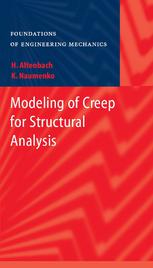

Most ebook files are in PDF format, so you can easily read them using various software such as Foxit Reader or directly on the Google Chrome browser.
Some ebook files are released by publishers in other formats such as .awz, .mobi, .epub, .fb2, etc. You may need to install specific software to read these formats on mobile/PC, such as Calibre.
Please read the tutorial at this link: https://ebookbell.com/faq
We offer FREE conversion to the popular formats you request; however, this may take some time. Therefore, right after payment, please email us, and we will try to provide the service as quickly as possible.
For some exceptional file formats or broken links (if any), please refrain from opening any disputes. Instead, email us first, and we will try to assist within a maximum of 6 hours.
EbookBell Team

4.1
10 reviews"Creep Modeling for Structural Analysis" develops methods to simulate and analyze the time-dependent changes of stress and strain states in engineering structures up to the critical stage of creep rupture. The principal subjects of creep mechanics are the formulation of constitutive equations for creep in structural materials under multi-axial stress states; the application of structural mechanics models of beams, plates, shells and three-dimensional solids and the utilization of procedures for the solution of non-linear initial-boundary value problems. The objective of this book is to review some of the classical and recently proposed approaches to the modeling of creep for structural analysis applications as well as to extend the collection of available solutions of creep problems by new, more sophisticated examples.
In Chapter 1, the book discusses basic features of the creep behavior in materials and structures and presents an overview of various approaches to the modeling of creep. Chapter 2 collects constitutive models that describe creep and damage processes under multi-axial stress states. Chapter 3 deals with the application of constitutive models to the description of creep for several structural materials. Constitutive and evolution equations, response functions and material constants are presented according to recently published experimental data. In Chapter 4 the authors discuss structural mechanics problems. Governing equations of creep in three-dimensional solids, direct variational methods and time step algorithms are reviewed. Examples are presented to illustrate the application of advanced numerical methods to the structural analysis. An emphasis is placed on the development and verification of creep-damage material subroutines inside the general purpose finite element codes.